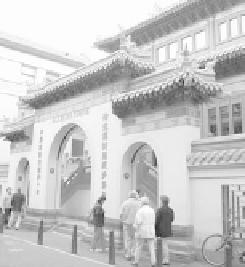Travel Reference
In-Depth Information
In the 1970s and 1980s, this street was unbelievably sleazy
(I live to tell)—a no-man's-land of junkies fighting amongst them-
selves. Today, it's increasingly trendy and upscale, fast becoming a
vibrant
neighborhood of urban diversity.
The street is a mix of ethnic restaurants (Thai and Portuguese)
and
bars, like the gay-oriented Queen's Head (at #20). The new
building at #30, built in “MIIM” (1998), offers apartments for rent
and sale to the neighborhood's new, upscale inhabitants.
The former Café 't Mandje (at #63) was perhaps Europe's first
gay bar (opened in 1927 and closed in 1985). It stands as a memo-
rial to owner Bet van Beeren (1907-1967), “Queen of the Zeedijk.”
The original Zee-dyke, Bet cruised the street in leather on her
motorcycle. The café's interior has been rebuilt as an exhibit in the
Amsterdam History Museum (see page 161).
Amsterdam's Chinatown is just around the corner, featuring
chickens in windows, some of the city's best Chinese restaurants
(such as Nam Kee at #113), and Asian gift shops.
It's easy to miss the
police station
(at #80, marked
Steunpunt
Zeedijk
), which is deliberately low-profile. In addition to patrolmen
on foot, the neighborhood is peppered with plainclothes cops.
• Making a right before the police station, this walk heads onto Korte
Stormsteeg street, back to the canalside red lights. But first, you may
wish to venture a block or two farther south, where you'll find a temple
and a prison...
The Lotus Flower Chinese Buddhist Temple
Enter this colorful, red-and-yellow, open-air temple by climbing
the stairs, passing through one of three entry arches represent-
ing the Buddhist Threefold Path (clean
living, meditation, and wisdom). Under
the roof, on lotus flowers, sits a statue of
Guan Yin, whose thousand hands are
always busy helping Buddha.
Three nuns (who live in the con-
vent) and Chinatown's faithful kneel
before the goddess, burn incense, and
offer her fruit and f lowers. The walls
hold terra-cotta panels bearing the
names of donors to this new addition
to the neighborhood (free, Tue-Sat
12:00-17:00, Sun 10:00-17:00, closed Mon, Zeedijk street).
The Waag and Nieuwmarkt
In 1488, this octagonal tower was the main gate of the city's east-
ern wall. Later, it became a weighing house
(Waag),
then a prison.
In the 1600s, the tower was an operating theater for med students,



















